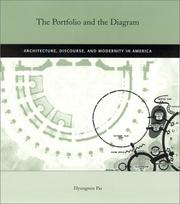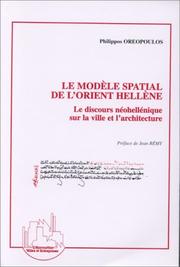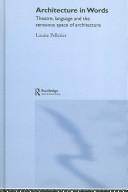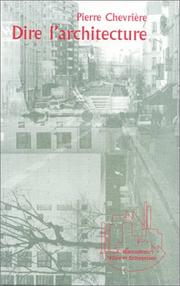| Listing 1 - 10 of 22 | << page >> |
Sort by
|
Book
ISBN: 1136445749 1136445757 020312457X Year: 2012 Publisher: London ; New York : Routledge,
Abstract | Keywords | Export | Availability | Bookmark
 Loading...
Loading...Choose an application
- Reference Manager
- EndNote
- RefWorks (Direct export to RefWorks)
Over recent decades, many museums, galleries and historic sites around the world have enjoyed an unprecedented level of large-scale investment in their capital infrastructure, in building refurbishments and new gallery displays. This period has also seen the creation of countless new purpose-built museums and galleries, suggesting a fundamental re-evaluation of the processes of designing and shaping of museums.Museum Making: Narratives, Architectures, Exhibitions examines this re-making by exploring the inherently spatial character of narrative in the museum and its potentia
Book

ISBN: 9783035622287 Year: 2020 Publisher: Basel Birkhäuser
Abstract | Keywords | Export | Availability | Bookmark
 Loading...
Loading...Choose an application
- Reference Manager
- EndNote
- RefWorks (Direct export to RefWorks)
Structural engineering --- Communication in architecture --- History.

ISBN: 0262162067 9780262162067 Year: 2002 Publisher: Cambridge (Mass.) : MIT press,
Abstract | Keywords | Export | Availability | Bookmark
 Loading...
Loading...Choose an application
- Reference Manager
- EndNote
- RefWorks (Direct export to RefWorks)
Book
ISBN: 9780262529426 0262529424 Year: 2016 Publisher: Cambridge : Mit Press,
Abstract | Keywords | Export | Availability | Bookmark
 Loading...
Loading...Choose an application
- Reference Manager
- EndNote
- RefWorks (Direct export to RefWorks)
Architecture --- Communication in architecture --- Originality in architecture --- Architecture, Postmodern --- Architecture, Modern --- Communication en architecture --- Architecture postmoderne --- Periodicals --- Périodiques --- Appropriation (Arts). --- Architecture and technology. --- Architecture, Postmodern. --- Communication in architecture. --- Originality in architecture.
Book
ISBN: 9781907896002 1907896007 Year: 2011 Publisher: London : Architectural Association,
Abstract | Keywords | Export | Availability | Bookmark
 Loading...
Loading...Choose an application
- Reference Manager
- EndNote
- RefWorks (Direct export to RefWorks)
Communication in architecture. --- Architecture --- Periodical editors --- Communication en architecture --- Architecture --- Rédacteurs en chef --- Interviews --- Périodiques --- Entretiens

ISBN: 2738469736 9782738469731 Year: 1998 Volume: *8 Publisher: Paris ; Montréal L'Harmattan
Abstract | Keywords | Export | Availability | Bookmark
 Loading...
Loading...Choose an application
- Reference Manager
- EndNote
- RefWorks (Direct export to RefWorks)
Architecture [Byzantine ] --- Architecture byzantine --- Architectuur [Byzantijnse ] --- Cities and towns --- Architecture --- Villes --- History --- Histoire --- Communication in architecture --- Communication in city planning --- City planning --- Architecture [Greek ] --- Influence --- Greece --- Communication in architecture - Middle East - History --- Communication in architecture - Balkan Peninsula - History --- Communication in city planning - Middle East - History --- Communication in city planning - Balkan Peninsula - History --- Architecture - Middle East - History - Sources --- Architecture - Balkan Peninsula - History - Sources --- City planning - Middle East - History - Sources --- City planning - Balkan Peninsula - History - Sources

ISBN: 9780415394710 9780415394703 0415394716 0415394708 9780203966884 9781134159246 9781134159284 9781134159291 Year: 2006 Publisher: New York : Routledge,
Abstract | Keywords | Export | Availability | Bookmark
 Loading...
Loading...Choose an application
- Reference Manager
- EndNote
- RefWorks (Direct export to RefWorks)
What if the house you are about to enter was built with the confessed purpose of seducing you, of creating various sensations destined to touch your soul and make you reflect on who you are? Could architecture have such power? Generations of architects at the beginning of modernity assumed it could. From the mid-eighteenth century onwards, architects believed that the aim of architecture was to communicate the character and social status of the client or to express the destination and purpose of a building. Architecture in Words explores the role of architecture as an expressive language through the transforming notion of character theory and looks at the theatre as a model for creating sensuous spaces in architecture. Since the beginning of the eighteenth century, the theatre was more than simply a form of entertainment; it changed how individuals related to one another in society. Acting was no longer restricted to the performing stage in theatres; it became a way to conduct oneself in society.Such transformations had obvious architectural repercussions in the design of theatres, but also in the configuration of the public and private domains. The succession of spaces, the careful crafting of lighting effects and the expressive role of architectural features were all influenced by parallel developments in the theatre. Pelletier examines the role of theatre and fiction in defining the notion of character in eighteenth century architecture. It suggests that while usually ignored by instrumental applications, character constitutes an important precedent for restoring the communicative dimension of contemporary architecture.
Theater architecture --- Theater --- Communication in architecture. --- Architecture --- Architecture des théâtres --- Théâtre --- Communication en architecture --- History --- Psychological aspects. --- Histoire --- Aspect psychologique

ISBN: 2738474926 9782738474926 Year: 1999 Publisher: Paris L'Harmattan
Abstract | Keywords | Export | Availability | Bookmark
 Loading...
Loading...Choose an application
- Reference Manager
- EndNote
- RefWorks (Direct export to RefWorks)
Architecture --- Communication in architecture. --- Architectural criticism --- Communication en architecture --- Critique d'architecture --- Study and teaching --- Etude et enseignement --- Architecture. --- Stedenbouw ; denken over --- Architectuurtheorie --- 711.4(A) --- 72.01 --- Stedenbouw. Ruimtelijke ordening ; denken over de stedenbouw --- Architectuur ; theorie, filosofie, esthetica --- Communication in architecture --- Communicative architecture --- Architecture, Western (Western countries) --- Building design --- Buildings --- Construction --- Western architecture (Western countries) --- Design and construction --- Art --- Building --- Architecture, Primitive
Book
ISBN: 9080757810 Year: 2002 Publisher: Barcelona Actar
Abstract | Keywords | Export | Availability | Bookmark
 Loading...
Loading...Choose an application
- Reference Manager
- EndNote
- RefWorks (Direct export to RefWorks)
Architecture --- Architecture and society --- Architectural design --- Communication in architecture --- Architecture et société --- Design architectural --- Communication en architecture --- Human factors --- Psychological aspects --- Philosophy --- Facteurs humains --- Aspect psychologique --- Philosophie --- 72.01 --- Architectuur (theorie) --- Architectuurtheorie --- Architecture et société
Book
ISBN: 9782917855225 2917855223 Year: 2011 Publisher: Paris B42
Abstract | Keywords | Export | Availability | Bookmark
 Loading...
Loading...Choose an application
- Reference Manager
- EndNote
- RefWorks (Direct export to RefWorks)
Cette publication est le résultat d'un atelier qui a consisté à conduire une recherche éditoriale et à mener diverses expérimentations, afin de restituer les interventions des invités, historiens et théoriciens de l'architecture, de l'art ou de l'écriture. L'Atelier s'est appuyé sur des constats simples et riches. Typographie et architecture entretiennent depuis toujours, dans l'espace du livre ou dans l'espace urbain, à l'échelle de la page, du monument ou de la ville, des relations étroites : modèle architectural pour la mise en forme du texte et le dessin de la lettre, ou modèle typographique pour l'épigraphie, invention et diffusion des formes architecturales par des moyens graphiques, ou encore concurrence symbolique entre l'écrit et le bâti dans la sphère publique. Ce terrain extrêmement riche permet d'explorer différents enjeux de la pratique du design graphique en les reliant aux problématiques esthétiques, anthropologiques et politiques développées par la théorie architecturale et urbaine, renouant ainsi le lien historique entre ces deux domaines qui furent, de la Renaissance aux Avant-gardes du XXe siècle, souvent considérés comme analogues, et qui donnèrent lieu parfois à des pratiques conjointes.
Printing --- Architectural design --- Architectural inscriptions --- Communication in architecture --- Book design --- Typographie --- Design architectural --- Inscriptions architecturales --- Communication en architecture --- Livres --- Congresses --- Congrès --- Mise en pages --- Mise en page --- Alphabet --- Caractère --- Edition --- Congrès
| Listing 1 - 10 of 22 | << page >> |
Sort by
|

 Search
Search Feedback
Feedback About UniCat
About UniCat  Help
Help News
News